Hamsters are fascinating creatures that have their origins in various countries and have adapted to thrive in specific natural habitats.
In the wild, hamsters can be found in warm, dry areas such as sand dunes or the edges of deserts. They have been documented in countries like Syria, Greece, Romania, Belgium, and northern China.
These natural habitats provide the ideal conditions for hamsters to dig and burrow, creating underground tunnels where they build their nests and store food.
Key Takeaways:
- Hamsters are well adapted to living in the wild without cages, toys, or human owners.
- They prefer warm, dry areas like sand dunes and the edges of deserts.
- Hamsters are skilled diggers and burrowers, creating underground tunnels for nesting and food storage.
- Wild hamsters can be found in countries like Syria, Greece, Romania, Belgium, and northern China.
- Pet hamsters often come from rodent mills, so adopting from ethical breeders or considering adoption and rescue centers is important.
Hamster Natural Habitat
Hamsters can be found in a variety of natural habitats, each tailored to the specific needs of their respective species.
These habitats provide them with the ideal conditions to thrive in the wild. From sandy deserts to grassy plains, hamsters have adapted to various environments over time.
One of the most common natural habitats for hamsters is the sand dunes found in locations like Syria. These sandy areas offer shelter and protection for these small rodents.
Hamsters are excellent diggers and burrowers, creating intricate tunnel systems beneath the dunes. These underground burrows provide them with a safe place to nest and store food.
In Greece, hamsters can be found in grassy plains and farmlands. These habitats provide them with an abundance of vegetation, which forms an important part of their diet.
Here, hamsters build their nests in tall grasses and use the surrounding vegetation as cover from predators.
Another natural habitat for hamsters is found in Romania, where they make their home in steppe and forest areas.
These habitats offer a diverse range of vegetation, allowing hamsters to forage for a variety of plant materials.
The forest provides additional cover, while the open steppe areas offer ample space for the hamsters to roam and explore.

| Country | Natural Habitat |
|---|---|
| Syria | Sand dunes |
| Greece | Grassy plains |
| Romania | Steppe and forest |
It’s important to note that these are just a few examples of the natural habitats where hamsters can be found.
They are highly adaptable creatures and can thrive in various environments, as long as their basic needs are met. Understanding their natural habitats is crucial for their conservation and overall well-being.
Wild Hamster Habitats
Wild hamsters exhibit remarkable adaptability and create their own unique habitats within their natural environments.
These habitats can vary depending on the hamster species and the geographical location where they are found. Let’s explore some of the fascinating habitats where wild hamsters thrive.
In Syria, hamsters can be found in the arid grasslands and steppes, where they dig intricate burrows beneath the ground.
These burrows not only serve as shelter but also provide protection from predators and the harsh desert climate.
Hamsters in Greece, on the other hand, inhabit agricultural fields and meadows, where they construct their nests within dense vegetation or underground.

In Romania, hamsters can be found in the South East Transylvanian Plain, where they have adapted to living in sandy soils.
Here, they create extensive burrow systems with multiple entrances and chambers for nesting, hibernation, and food storage.
Belgium is another country where hamsters thrive, particularly in open landscapes with a mix of grasslands and farmlands. They primarily utilize the grassy areas for foraging and nesting.
In northern China, hamsters inhabit the steppe landscapes, including the Inner Mongolian Plateau. They are well-adapted to the extreme temperature variations, digging burrows deep into the ground to escape the heat of summer and the cold of winter.

These burrows can extend up to two meters underground, providing a safe haven for these resilient creatures.
Challenges for Wild Hamsters
Despite their remarkable adaptability, wild hamsters face various challenges in their natural habitats.
Their near-sightedness and colorblindness make them vulnerable to predators, as they struggle to detect threats from a distance.
Loud noises can also startle them, affecting their ability to hunt for food and reproduce.
Extreme temperatures, especially during harsh winters or scorching summers, can put a strain on their survival.
Additionally, habitat loss due to urbanization and agricultural expansion poses a significant threat to wild hamsters.
Conservation efforts are crucial to protect these unique habitats and ensure the long-term survival of wild hamster populations.
| Country | Natural Habitat | Conservation Initiatives |
|---|---|---|
| Syria | Arid grasslands and steppes | Efforts to protect and restore habitat through controlled grazing and land management. |
| Greece | Agricultural fields and meadows | Conservation programs promoting sustainable farming practices to preserve hamster habitats. |
| Romania | Sandy soils in the South East Transylvanian Plain | Establishment of protected areas and conservation education initiatives. |
| Belgium | Grasslands and farmlands | Implementation of agri-environmental schemes and habitat restoration projects. |
| Northern China | Steppe landscapes | Collaboration between conservation organizations and local communities to protect and manage hamster habitats. |

Understanding the natural habitats of wild hamsters and the challenges they face is essential for their conservation.
By supporting ethical breeding practices and considering adoption from rescue centers, we can all contribute to the preservation of these fascinating creatures and their unique environments.
Hamsters in Syria
Syria is home to several species of hamsters, each with its own distinct habitat and ecological significance.
These small rodents thrive in the arid regions of the country, particularly in the desert and semi-desert areas.

The different species of hamsters found in Syria include the Golden Hamster (Mesocricetus auratus) and the lesser-known Roborovski Hamster (Phodopus roborovskii).
The Golden Hamster, also known as the Syrian Hamster, is perhaps the most popular and widely recognized hamster species.
It is native to the dry steppes and the edge of the Syrian desert. With its golden fur and stocky build, the Golden Hamster has become a beloved pet worldwide.
However, it is important to note that wild Golden Hamsters are endangered, and conservation initiatives are in place to protect their natural habitat.
The Roborovski Hamster, on the other hand, is the smallest and fastest of all hamster species. It inhabits the sand dunes and sandy plains of Syria.
With its sandy-colored fur and exceptional energy, the Roborovski Hamster is a remarkable creature.
These hamsters are known for their remarkable burrowing abilities and their adaptation to the extreme temperatures of their natural habitat.
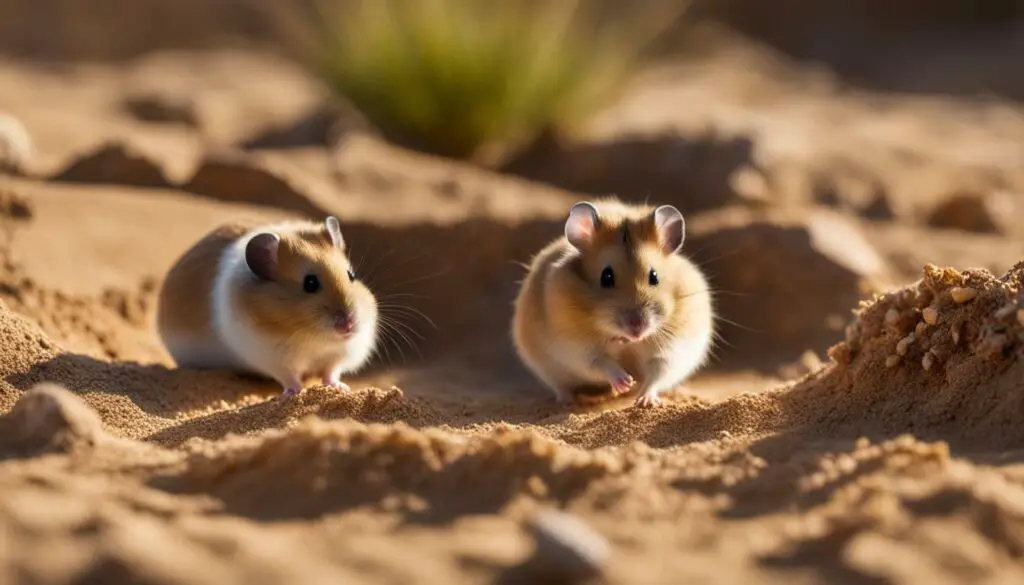
Conservation Efforts in Syria
Due to the significance of hamsters in the ecosystem and the conservation value they hold, initiatives have been implemented to protect their habitats in Syria.
These efforts aim to preserve the natural balance and biodiversity of these fragile ecosystems, ensuring the survival of these unique hamster species.
Conservation projects focus on raising awareness about the importance of preserving hamster habitats, encouraging sustainable land management practices, and combating the threats that hamsters face, such as habitat loss and degradation.
These initiatives promote research, education, and community engagement to promote the long-term survival of hamsters in their natural environments.
| Hamster Species | Habitat | Conservation Status |
|---|---|---|
| Golden Hamster | Syrian desert and dry steppes | Endangered |
| Roborovski Hamster | Sand dunes and sandy plains | Least Concern |
Hamsters in Greece
Hamsters in Greece occupy specific habitats that support their survival and contribute to the overall biodiversity of the region.
These habitats include grasslands, scrublands, and agricultural fields. Greek hamsters (Mesocricetus grecus) are a distinct species found primarily in parts of northern and central Greece, as well as a few neighboring Balkan countries.
These hamsters prefer areas with dense vegetation and soft soil, allowing them to create elaborate burrows.
Their burrows can reach depths of up to half a meter and include multiple entrances and chambers for nesting, storing food, and escaping predators. The Greek hamster’s diet mainly consists of seeds, fruits, and some insects.
Conservation initiatives in Greece are focused on protecting the natural habitats of hamsters by implementing measures to preserve and restore their preferred grasslands and agricultural lands.
Efforts are being made to promote sustainable farming practices and raise awareness among local communities about the importance of hamster conservation.
| Greek Hamster Facts | |
|---|---|
| Scientific Name | Mesocricetus grecus |
| Habitat | Grasslands, scrublands, agricultural fields |
| Unique Characteristics | Elaborate burrow systems, primarily nocturnal |
| Conservation Status | Endangered |
“The preservation of the Greek hamster’s natural habitat is crucial for the survival of this unique species and the ecological balance of the region.”

Despite their ecological significance, Greek hamsters face multiple threats to their survival. Habitat loss due to urbanization, intensification of agriculture, and land degradation poses a significant risk.
Additionally, the fragmentation of their habitat further isolates populations, limiting gene flow and increasing the vulnerability of the species.
Conservation organizations in Greece are actively working towards protecting the Greek hamster through various initiatives.
These include habitat restoration projects, raising public awareness, and collaborating with farmers to promote sustainable agricultural practices that benefit both hamsters and local economies.
Efforts are also underway to establish protected areas and implement guidelines to reduce the impact of infrastructure development on hamster habitats.
By preserving the natural habitats of Greek hamsters and ensuring their long-term survival, we contribute not only to the conservation of a unique species but also to the overall biodiversity and ecological balance of the region.
Hamsters in Romania
Romania provides important natural habitats for various hamster species, and efforts are underway to ensure their long-term survival.
These small rodents thrive in the country’s grasslands and agricultural fields, where they find ample food and suitable burrowing sites.
The hamsters’ ability to adapt to different habitats has allowed them to establish stable populations in Romania.
One notable hamster species found in Romania is the European hamster (Cricetus cricetus). These elusive creatures are known for their distinctive appearance, with stocky bodies, short tails, and large cheek pouches.
They are skilled diggers, excavating complex burrows that can reach several meters in length. These burrows serve as protection from predators and provide safe nesting chambers for raising their young.
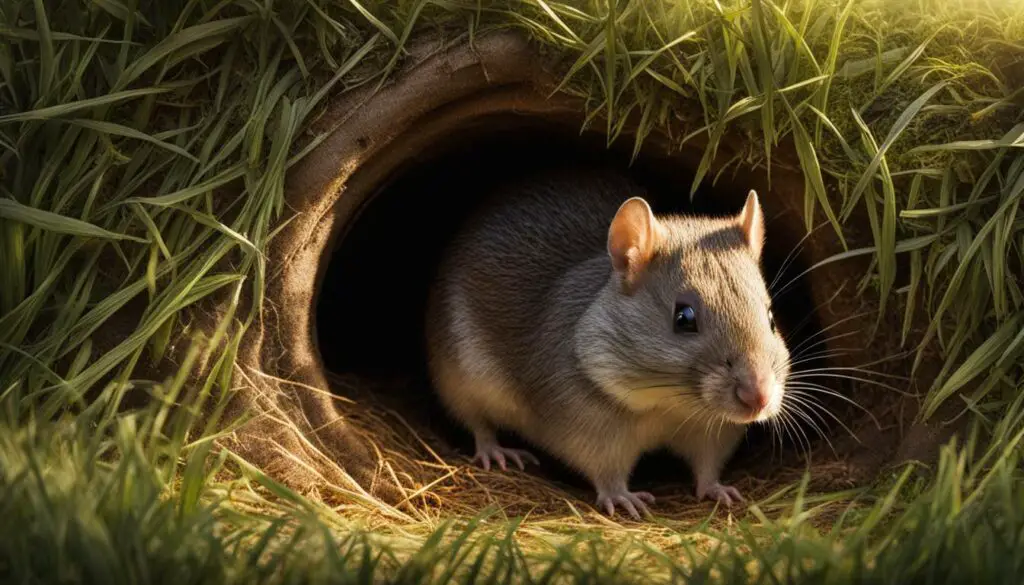
Conservation initiatives in Romania aim to preserve the natural habitats of hamsters and protect their populations.
Efforts include the creation of protected areas and the implementation of agricultural practices that promote habitat conservation.
By maintaining suitable grassland habitats and minimizing the use of pesticides, Romania seeks to ensure the long-term survival of hamsters and other wildlife species.
Understanding the importance of these natural habitats and supporting conservation initiatives is crucial to safeguarding the future of hamsters in Romania.
By respecting their wild habitats, we can contribute to the preservation of these fascinating creatures and the ecosystems they inhabit.
| Hamster Species | Habitat | Conservation Status |
|---|---|---|
| European Hamster (Cricetus cricetus) | Grasslands and agricultural fields | Endangered |
| Common Hamster (Cricetus cricetus) | Grasslands and farmland | Near threatened |
“Romania provides important natural habitats for various hamster species, and efforts are underway to ensure their long-term survival.”
Hamsters in Belgium
Belgium boasts diverse hamster habitats, and conservation measures aim to maintain the delicate balance of these ecosystems.
Wild hamsters in Belgium can be found in agricultural landscapes, particularly in areas with a mix of crops, grasslands, and hedgerows.
These habitats provide a variety of food sources and shelter for hamsters, allowing them to thrive.
“The hamster is an important part of our natural heritage,” says Dr. Marieke Joosten, a wildlife biologist involved in hamster conservation efforts.
“We have a responsibility to safeguard their habitats and protect these small creatures.”
Conservation initiatives in Belgium focus on preserving and restoring hamster-friendly environments.
Farmers are encouraged to implement agricultural practices that benefit hamsters, such as maintaining diverse crop rotations and leaving strips of undisturbed vegetation along field edges.
These measures help create suitable conditions for hamsters to build their burrows and forage for food.
“By integrating hamster-friendly practices into agriculture, we can ensure the long-term survival of this species while also promoting sustainable farming,” explains Dr. Joosten.
“It’s a win-win situation for both wildlife conservation and agricultural productivity.”
| Conservation Measures | Impact |
|---|---|
| Implementation of hamster-friendly farming practices | Enhanced habitat availability and quality |
| Creation of nature reserves and protected areas | Safe havens for wild hamsters |
| Public awareness campaigns | Education about hamster conservation and importance of habitat preservation |
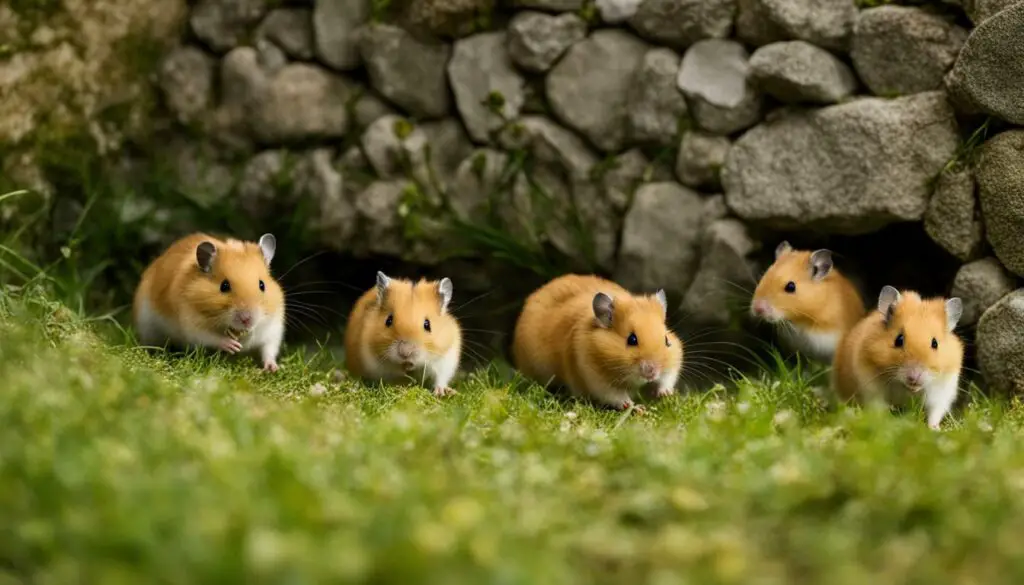
The efforts in Belgium have shown promising results, with an increase in hamster populations in certain areas. However, continued dedication and collaboration between scientists, farmers, and policymakers are essential for the long-term conservation of wild hamsters in Belgium.
Hamsters in Northern China
Northern China is home to several hamster species, with their habitats playing a crucial role in the region’s ecological equilibrium.
These species, including the Chinese striped hamster and the Mongolian hamster, have adapted to the unique environmental conditions of the area.
Hamsters in Northern China inhabit grasslands, steppes, and farmlands. They construct intricate burrow systems beneath the ground, providing them with shelter from predators and extreme temperatures.
These underground dwellings also serve as storage areas for food, allowing hamsters to gather and store seeds, grains, and plant matter for sustenance.
Hamsters in this region are an important part of the ecosystem, contributing to soil aeration and nutrient cycling.
They help maintain a balance by controlling plant growth through seed dispersal and predation on insects.
However, their populations have been impacted by factors such as habitat loss due to agriculture and urbanization.
To conserve hamsters in Northern China, various initiatives have been implemented. These include habitat restoration projects, public awareness campaigns, and research on their behavior and genetic diversity.
Efforts are being made to create protected areas and implement sustainable farming practices that take into account the needs of these small but significant creatures.
Conservation Efforts in Northern China
In recent years, there has been a growing recognition of the importance of preserving the natural habitats of hamsters in Northern China.
Conservation organizations, local communities, and government authorities are working together to safeguard these habitats and promote responsible land use practices.
The conservation efforts in Northern China aim to ensure the long-term survival of hamster populations and the preservation of their ecological roles.
By protecting their natural habitats and raising awareness about the importance of these small mammals, steps are being taken towards maintaining the region’s biodiversity and ecological equilibrium.
| Hamster Species | Habitat | Conservation Status |
|---|---|---|
| Chinese Striped Hamster | Grasslands, farmlands | Stable |
| Mongolian Hamster | Steppe grasslands, farmlands | Vulnerable |
| Northern Three-toed Jerboa | Desert, sandy areas | Near Threatened |
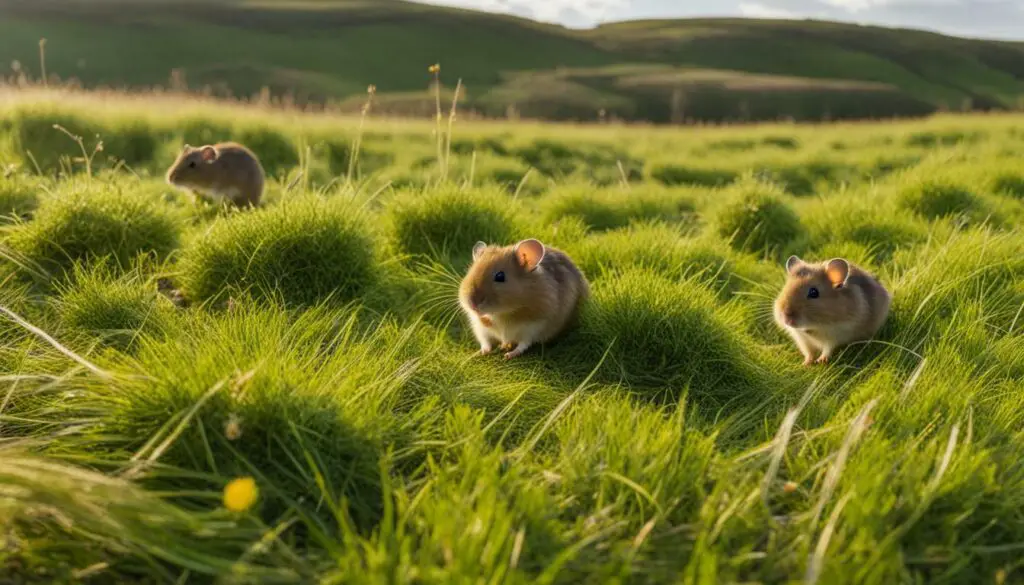
Challenges for Wild Hamsters
Despite their adaptability, wild hamsters encounter various challenges in their natural habitats that affect their well-being and survival.
Hamsters, with their near-sightedness and colorblindness, have limited visual perception, making it difficult for them to detect predators or navigate their surroundings efficiently.
This vulnerability puts them at a higher risk of predation and increases their chances of encountering dangerous situations.
Additionally, hamsters rely heavily on their sense of hearing to detect potential threats in their environment.
Loud noises, such as thunderstorms or human activities, can startle them and disrupt their normal behaviors.
Such disturbances can cause stress and anxiety among wild hamsters, compromising their overall health and reproductive success.
Extreme temperatures also pose a significant challenge for wild hamsters. These small rodents are adapted to warm, dry climates and have limited tolerance for dramatic temperature fluctuations.
Harsh weather conditions, be it scorching heat or freezing cold, can negatively impact their ability to find food and water, locate suitable shelter, and regulate their body temperature.
As a result, their survival becomes even more precarious.
| Challenges for Wild Hamsters | Impact |
|---|---|
| Poor visual perception | Vulnerable to predation and environmental hazards |
| Sensitivity to loud noises | Heightened stress levels and disrupted behavior patterns |
| Extreme temperatures | Food and water scarcity, compromised ability to regulate body temperature |
“Wild hamsters face numerous challenges in their natural habitats, including poor eyesight, sensitivity to loud noises, and extreme temperatures. These factors can significantly impact their well-being and survival.”
Understanding the challenges wild hamsters encounter is crucial for implementing effective conservation strategies.
Conservation initiatives aimed at preserving their natural habitats, reducing human-induced disturbances, and raising awareness about the importance of their ecological role can help ensure the long-term survival of these fascinating creatures.

- Competition for resources with other rodent species
- Loss of habitat due to agriculture and urbanization
- Fragmentation of habitat leading to isolation of populations
- Predation by natural predators such as owls, foxes, and snakes
- Increased vulnerability to diseases and parasites
Hamsters in Pet Stores
Hamsters found in pet stores often come from breeding facilities with questionable welfare standards, emphasizing the importance of responsible sourcing.
These rodents are often bred in large quantities, prioritizing profit over the well-being of the animals. The conditions in these rodent mills can be cramped, unsanitary, and stressful for the hamsters.
As a result, they may suffer from health issues and have compromised immune systems.
It is crucial for pet owners to consider adopting hamsters from ethical breeders or explore adoption and rescue centers.
Ethical breeders prioritize the overall health and well-being of their animals, providing them with proper care, adequate space, and socialization.
By adopting from these sources, you can ensure that you are supporting responsible breeding practices and providing a loving home for a hamster in need.
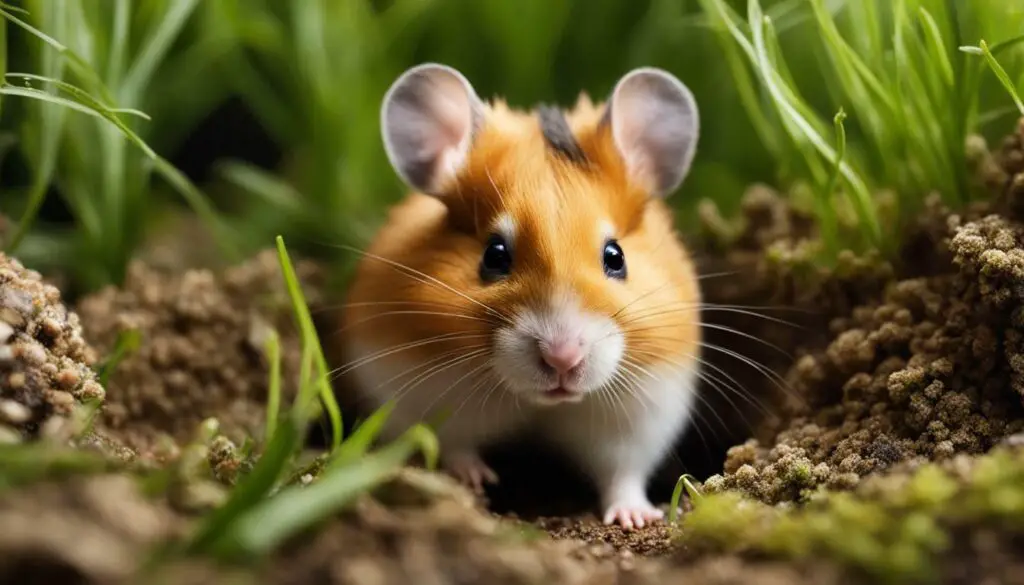
In addition to considering adoption, it is important to create a suitable habitat for your pet hamster. Hamsters thrive in environments that mimic their natural habitats.
Provide them with a spacious cage equipped with bedding material, tunnels, hiding spots, and a wheel for exercise.
It is crucial to maintain proper hygiene by regularly cleaning the cage and providing fresh food and water daily.
Ensuring a suitable environment will help keep your pet hamster healthy, happy, and content.
Key Points:
- Hamsters in pet stores often come from breeding facilities with questionable welfare standards.
- Consider adopting hamsters from ethical breeders or adoption and rescue centers.
- Create a suitable habitat for your pet hamster, mimicking its natural habitat.
| Pros of adopting from ethical breeders or adoption centers | Cons of buying from pet stores |
|---|---|
|
|
“The conditions in rodent mills can lead to hamsters suffering from health issues and compromised immune systems.” – Hamster welfare expert
Ethical Adoption and Conservation
By choosing ethical adoption practices, individuals can contribute to the conservation of hamsters and their natural habitats.
When considering adding a hamster to your family, it is crucial to support reputable breeders who prioritize the welfare of the animals.
Avoid purchasing hamsters from rodent mills, which are breeding facilities that prioritize quantity over quality of care.
These mills often keep hamsters in overcrowded and unsanitary conditions, leading to various health issues and a decreased quality of life for the animals.
Instead, look for breeders who prioritize ethical practices, such as providing proper housing, nutrition, and socialization for their hamsters.
Ethical breeders will ensure hamsters are bred responsibly, with a focus on maintaining genetic diversity and promoting overall hamster well-being.
Adopting from ethical breeders not only guarantees a healthier and happier hamster but also supports responsible hamster breeding practices.
If you are open to alternative options, consider adopting a hamster from an adoption or rescue center.
These centers often have hamsters in need of loving homes, and adopting from them can help alleviate the strain on wild hamster populations.
Additionally, adoption and rescue centers typically provide comprehensive care and rehabilitation for hamsters before they are placed in new homes, ensuring their well-being is prioritized.
By choosing ethical adoption practices, you not only provide a loving home for a hamster but also contribute to the conservation efforts of these fascinating creatures and their natural habitats.
Together, we can make a difference in the lives of hamsters and ensure their continued survival in the wild.
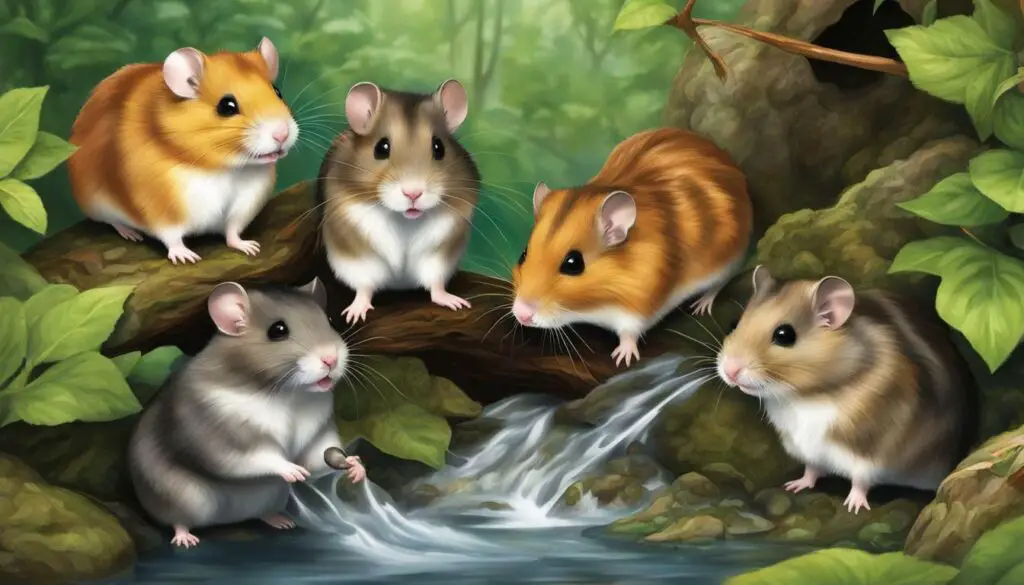
Understanding where hamsters live outside of pet stores is crucial for their well-being and supports conservation efforts to protect their natural habitats. Hamsters are well adapted to living in the wild, thriving in warm and dry environments such as sand dunes and the edges of deserts. They can be found in various countries, including Syria, Greece, Romania, Belgium, and northern China.
In the wild, hamsters are skillful diggers and burrowers, creating intricate tunnel systems underground where they build their nests and store food in their expandable cheek pouches. However, these adorable creatures face challenges in their natural habitats. They are near-sighted and colorblind, relying on their other heightened senses to navigate their surroundings. Loud noises and extreme temperatures can also pose threats to their well-being.
Unfortunately, in pet stores, hamsters often come from rodent mills, which are breeding facilities that prioritize quantity over the welfare of the animals. These mills do not provide an adequate environment for the hamsters, devoid of the natural habitats they require to thrive. As conscientious pet owners, it is important to consider ethical alternatives for adopting hamsters.
By adopting hamsters from ethical breeders or considering adoption and rescue centers, you can support conservation efforts and ensure the well-being of these adorable creatures. Ethical breeders prioritize the health and happiness of the hamsters they breed, providing them with suitable living conditions and care. Adoption and rescue centers strive to find loving homes for hamsters in need, further contributing to the conservation of these fascinating animals.
FAQ
Q: Do hamsters live in the wild without cages, wheels, toys, or owners?
A: Yes, hamsters are well adapted to living in the wild without cages, wheels, toys, or owners. They are naturally suited to their wild habitat.
Q: Where do hamsters live in the wild?
A: Hamsters typically live in warm, dry areas like sand dunes or the edge of deserts in countries such as Syria, Greece, Romania, Belgium, and northern China.
Q: How do hamsters create their habitats in the wild?
A: Hamsters are excellent diggers and burrowers. They create tunnels underground where they nest and store food in their cheek pouches.
Q: What challenges do wild hamsters face in their natural habitats?
A: Wild hamsters face challenges such as being near-sighted, colorblind, and vulnerable to loud noises and extreme temperatures.
Q: Where do pet store hamsters typically come from?
A: Pet store hamsters often come from rodent mills, which are breeding facilities that prioritize quantity over the welfare of the animals.
Q: Is it important to adopt hamsters from ethical breeders or consider adoption and rescue centers?
A: Yes, it is important to adopt hamsters from ethical breeders or consider adoption and rescue centers to support responsible breeding practices and conservation efforts.




